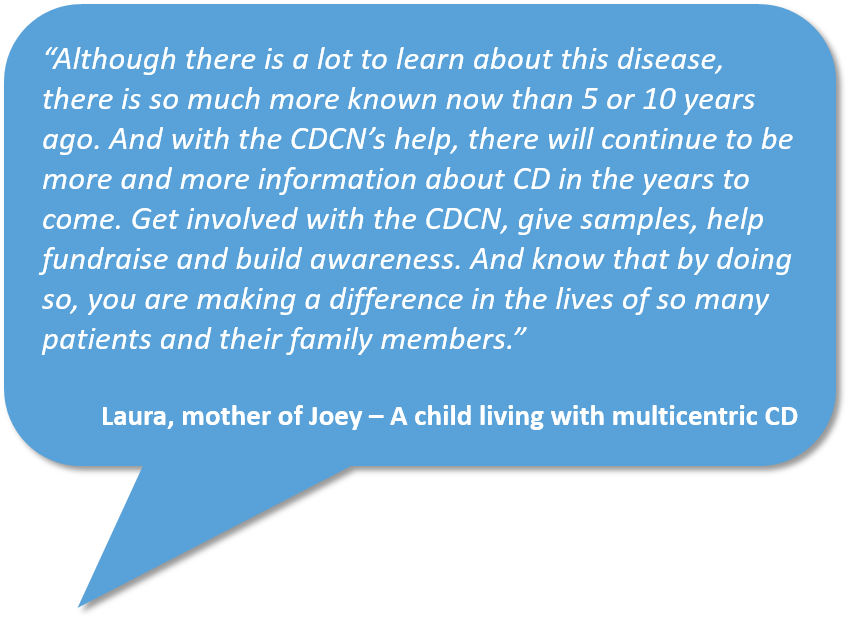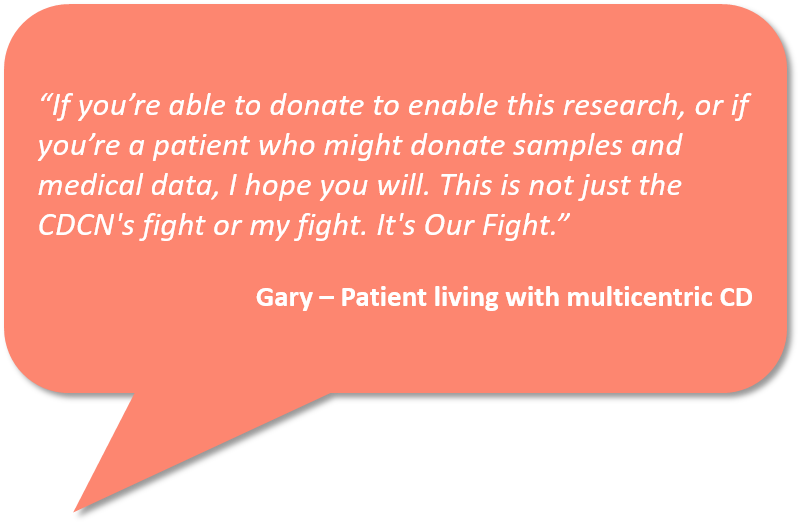Castleman disease: How to contribute to research?
Published May 11, 2021 • By Lauriane Armand
At present, the treatment strategies used in the different forms of Castleman disease (CD) are not sufficiently effective in combating this rare and complex condition.
In order to find new treatment options, it is imperative to understand the disease as well as possible. However, there are still many grey areas surrounding the causes of Castleman disease, and these are currently the subject of intense research.
How do researchers make progress despite the rarity of CD? In what way does a biobank of tissue samples help to speed up research?
We explain it all in our article!

Why are we interested in tissue samples?
CD is characterised by very specific lymph node histological images (of tissues) and is responsible for hyperactivation of the immune system which alters blood chemistry in white blood cells and in inflammatory molecules.
In fact, these particular histological images are what make it possible to distinguish CD from other pathologies with similar appearances, this is called a differential diagnosis.
To learn more, explore our article on Castleman disease and differential diagnosis.
For their research work, researchers therefore rely on the study of blood and tissue samples from different patients to advance our understanding and by extension, to make progress in the fight against CD.
However, due to the scarcity of CD, collecting samples presents a real challenge for researchers who have very few resources available on which to work.
In 2017, the collaborative research project led by the Castleman Disease Collaborative Network (CDCN) therefore established CastleBank, the very first biobank of samples from patients suffering from CD.
What is a biobank?
Biobanks are essential research organisations where biological samples such as fluid (blood, saliva) and tissues are collected and stored. These samples can then be made available to qualified researchers so they can study them.

Source: genengnews
In the case of CastleBank, only researchers who have submitted an application to the CDCN and who have been approved by the Biobank Advisory Committee will be able to access biological samples and clinical data.
Blood or saliva samples may also be collected from family members of CD patients.
These different samples can be used immediately, banked for later use or transformed into DNA, cell lines, tissue microarrays...
CastleBank is specific to Castleman disease, which means that all the collected samples are designed for research into this disease.
How do sample donations drive research forward?
The collection of different samples at various stages of CD makes it possible to conduct comparative studies and to understand the disease and its physiopathological mechanisms more quickly.
In 2019, DNA sequencing of lymphatic lymph node tissue and the study of different documented mutations helped to identify, in particular, a somatic mutation (which is not hereditary) of a gene coding for a receptor (PDGFR). This mutation has been identified in 7 samples from 41 patients suffering from the idiopathic monocentric form or just over 17%.
This somatic mutation is by definition not present in all the cells and is acquired over a lifetime.
Thorough research showed that the mutations of this receptor can potentially modify the characteristics and function of cells so as to induce symptoms of the idiopathic monocentric form of CD.
To identify in this way mutations and potential causes of the disease, it allows us to consider new treatment targets which might one day provide a cure for the disease.
To learn more, explore our article on the advancing research in Castleman disease.
How give a donation?
The best time to give samples is when the patients are newly diagnosed or have a relapse of their symptoms. The samples from this period are much more likely to reveal information on CD and the causes of recorded symptoms.
If you're ready to make a donation and you are newly diagnosed, currently hospitalized or in the case of relapse or flare-up of your symptoms, you can contact the coordinator of Biobank, Johnson Khor, at the following email address: castlebank@uphs.upenn.edu.
Castlebank accepts both samples previously collected within the framework of past medical procedures as well as samples which will be obtained during future medical procedures or blood tests. Saliva and stool samples are also accepted.
It should be noted that the CDCN is committed to all logistics and costs associated with the transfer of samples. The team works with the patients to identify and collect all past samples and coordinate the transfer of samples from future medical procedures.
Patients have the possibility to provide one or several samples and are free to leave the study at any point.
For more information on the donation of biological samples, you can visit the CDCN website or click here.
Another form of donation: Sharing information
The CDCN is also responsible for the ACCELERATE register, the first ever worldwide register of patients with CD.
Registration onto this register allows patients and their relatives to donate their medical records for research into CD. These records will then be anonymized to guarantee confidentiality of everyone's health related data.
It is also a voluntary process which makes it possible to study and to once again compare the range of appearances and to manage the pathology with the aim of improving medical care.
The study from shared records has shown that CD affects patients in different ways and that each person doesn't respond in the same way to treatments delivered. The collection of this health data helps to broaden our understanding of the disease and to make progress in research and the management of it.
In the United States patients can register directly and in Europe, registration is carried out by doctors.
For more information about the ACCELERATE register, you can visit the CDCN website or click here
What do patients and relatives think of this approach?



For further reading:
Don't hesitate to visit the CDCN website (Castleman Disease Collaborative Network) for more information.
You can also join the “Castleman disease forum” on Carenity to share your experience, find support and exchange information with other patients or relatives.
If you'd like to make you voice heard, let us know! Share your experience and what you've been through (your diagnosis, journey, etc.).
Would you like to share your story? Contact us at this address: contact@carenity.com.
Sources:
- Biobanque du Réseau de collaboration sur la maladie de Castleman, Good Clinical Practice Network
- Dispenzieri, Angela, and David C. Fajgenbaum. “Overview of Castleman Disease.” Blood, vol. 135, no. 16, 2020, pp. 1353–1364., doi:10.1182/blood.2019000931.
- Donate Tissue Samples, Castleman Disease Collaborative Network
- ACCELERATE Natural History Study, CDCN
- Li, Z., Lan, X., Li, C. et al. Recurrent PDGFRB mutations in unicentric Castleman disease. Leukemia 33, 1035–1038 (2019). https://doi.org/10.1038/s41375-018-0323-6
- Registre international, Castleman FR

 Facebook
Facebook Twitter
Twitter

